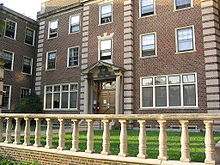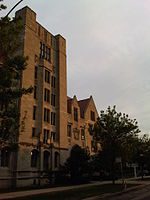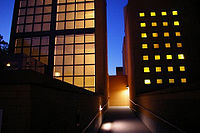- Housing at the University of Chicago
-
Housing at the University of Chicago includes 10 residence halls that are divided into 35 houses. Each house has an average of 70 students.[1] Freshmen must live on-campus, and housing is guaranteed but not required thereafter.[2] The University operates 28 apartment buildings near campus for graduate students.[3]
Approximately 60% of undergraduates live on campus.
Contents
Residence halls
Blackstone Hall
Blackstone Hall is at 5748 S. Blackstone Ave. and accommodates 79 residents. It was built in 1931 and acquired in 1953.[4] It has six floors and students share a bathroom and kitchen, and have individual rooms. Blackstone Hall has one house, the Blackstone House.[5]
Floors two through six serve to house students, while the first floor has a lounge area with a fireplace, front desk, untuned piano, vending machines, laundry room, computer lab, study room, and other amenities. There is a further lounge with a ping-pong table on the sixth floor.
Breckinridge Hall
Breckinridge Hall is at 1442 East 59th St. It currently accommodates 92 residents plus two RAs, and will be increasing its capacity by three beginning Fall Quarter 2010. One of the smaller dormitories on campus, it houses undergraduates, though it served graduate students in the past. Approximately two-thirds of the rooms are single residence rooms.
In 1898, Ina Law Robertson, an Oregon schoolteacher who came to Chicago to study at the University of Chicago, founded "Eleanor Club"[6] to offer affordable housing for employed, single women.[7] The Eleanor Club was very similar to YWCAs.[8][9] Robertson eventually built six residences, with this one being designed by Schmidt, Garden and Martin and opened in 1916.[10] The building was purchased by the University of Chicago in 1968.[7] The proceeds of the sale created an endowment that funds grants for Chicago women and girls in need of financial assistance.[6] The University then named the building after Sophonisba Preston Breckinridge who was the Dean of the Chicago School of Civics and Philanthropy, which was the University of Chicago's first graduate school of social work.[10] Breckinridge was also the first woman to graduate from the law school of the University of Chicago.
There is only one college house in Breckinridge Hall, called Breckinridge House.
Broadview Hall
Broadview Hall is at 5540 S. Hyde Park Blvd. and accommodates 200 residents. Originally built as a hotel, as a dormitory it is organized into three "houses": Wick (the 2nd and 3rd floors), Talbot (the 4th and 5th floors), and Palmer (the 6th and 7th floors).[11] Most rooms are single with private baths.[12] Broadview is about a 20-minute walk from the main campus, and about a 15 minute walk from Pierce Tower, where Broadview students eat.[13]
Burton–Judson Courts
Main article: Burton–Judson CourtsBurton–Judson Courts (BJ) is located at 1005 E. 60th St. and accommodates 313 students. Burton–Judson is one of the few undergraduate residences located south of the Midway Plaisance, it is a castle-like edifice built in a Gothic style similar to that of the University's main quadrangles.[14] It was designed by the Philadelphia firm of Zantzinger, Borie, and Medary.[14] Burton-Judson was the first on-campus residence of eminent astronomer Carl Sagan, who lived in room 141 (See "Carl Sagan, A Life"). Burton-Judson contains six houses: Dodd-Mead, Salisbury, Linn-Mathews, Coulter, Chamberlin, and Vincent.
Maclean Hall
Pronounced either "mc-lane" or "mac-leen," Maclean Hall is located at 5445 S. Ingleside Ave. and accommodates 98 residents (94 in singles, 4 in two doubles). Although it is part of the university, it is located in a different ZIP code (60615) from the rest of campus and is not featured on most campus maps despite being only one block North of the Gerald Ratner Athletics Center. The four-story building, originally built as a parish retirement home, was acquired by the university and renovated in 1991.[15] Maclean Hall features the most common space of any house in the Housing System, including a full commercial kitchen that residents may use, a large central lounge and dining room, a solarium, a basement game room and an assembly room with a 15' projector wall. It is named for Norman Maclean, a University of Chicago professor and author of the novel A River Runs Through It. The Maclean House is the only house of the dorm.
Max Palevsky Residential Commons
The Max Palevsky Residential Commons is located at 1101 E. 56th St. and accommodates 712 people. The buildings were designed by Ricardo Legorreta, and opened in 2001. Dining is provided in the Bartlett Commons.[16] Three buildings comprise the Commons, sharing a common basement, while students are assigned to one of eight houses (in-dorm communities) spread amongst the buildings: Alper, Hoover, and May Houses in Max Palevsky East; Flint, Graham, and Woodward Houses in Max Palevsky Central; and Rickert and Wallace Houses in Max Palevsky West. All houses are co-ed, although Hoover maintains single-sex floors.[16]
The buildings' name recognizes alumnus Max Palevsky, who had donated $20 million to the university "to enhance the quality of residential life on campus."[17] Blair Kamin, a Chicago Tribune architectural critic, wrote after their 2002 opening that the buildings "...just [don't] come off."[18] Subsequent architectural criticism has been more favorable, finding that the buildings' layout meets the needs of the modern student body and that their colors and windows echo those of their neighbors.[19]
Pierce Tower
Pierce Tower is located at 5514 S. University Ave. and accommodates 250 residents. It stands 10 stories high.[20] All of its houses are co-ed.[21] More formally known as Stanley R. Pierce Hall,[22] it was constructed during the 1950s and completed in 1960 at a cost of $2,400,000.[22][23][24] Its architect was Harry Weese of Harry Weese & Associates.[22] The journal Architectural Record described it as a "major breakthrough on the anti-slab front"; built while Hyde Park was undergoing urban renewal, it has also been described as a fortress.[22][25] It was designed to connect to a twin building, which was never built.[22] Stanley R. Pierce, a fullback for the Chicago Maroons who had gone on to a career as a broker, had willed the university $800,000.[24] The money proved somewhat difficult to locate. Pierce had left a variety of clues that led to the discovery of buried gold coins.[25]
In 1970 the Gay Liberation Front sponsored one of the first openly announced same-sex mixers in Chicago at the dormitory.[26]
Pierce contains four residential houses: Tufts, Henderson, Thompson, and Shorey.[27]
Snell–Hitchcock Hall
Main article: Snell–HitchcockSnell-Hitchcock Hall is located at 1009 E. 57th St. and houses 156 residents. It sits on the main campus quad and was built in 1901. Formally Amos Jerome Snell Hall and Charles Hitchcock Hall, more commonly known as Snell–Hitchcock or Hitchcock–Snell, was built in 1892 (Snell) and 1901 (Hitchcock). They are the oldest residence halls still in use as such on campus. Snell is built in a collegiate-Gothic style, while Hitchcock is Prairie Style inspired Gothic. The buildings both feature limestone exteriors and fireplaces, hardwood molding and trim.
Snell–Hitchcock is currently known for having a high level of community spirit and involvement, which are best displayed at the annual University of Chicago Scavenger Hunt. Also known as Scav Hunt, it marks the high point of the year for many of the inhabitants of the two dorms; as of 2009, the Snell–Hitchcock team has won 11 of the 23 hunts to date.[28] The dorm is on the northwest corner of the University's Main Quadrangles at the corner of 57th St. and Ellis Avenue. It is connected via emergency exits to Searle Chemistry Laboratory.
Hitchcock was built in 1901, and is listed in the National Register of Historic Places. It is built in a collegiate Gothic style, like Snell and most of the University of Chicago's campus, but has many Prairie School elements, such as stone corn husks instead of gargoyles and flat-roofed instead of gabled dormers.
Hitchcock is built in the European "landing" style of dormitory with five stairwells linked through the front cloister and basement, though only the basement is used now in order to ensure that the building is more secure. The three interior "sections" (Sections II-IV) are each built around a single staircase. Each interior Section consists of two floors of four double-rooms with a fourth floor that has two suites (doubles with a large living room and separate bedroom). Most of the rooms have non-working fireplaces. The first floor houses the apartment for the Resident Masters, a live-in faculty couple. Traditionally, each section has had a women-only and a men-only floor, with the suite floor being either single or mixed-sex depending on the desires of the residents.
South Campus Residence Hall
The South Campus Residence Hall (SCRH) is located in Woodlawn, south of the Midway Plaisance at 6031 S. Ellis Ave. and accommodates 811 residents. It opened in 2009 and is split into two sections, defined by a courtyard for each. The dorm contains eight college houses.[29] South Campus West contains houses Keller, Halperin, Kenwood, and Del Giorno, while South Campus East contains Jannotta, Chautauqua, Crown, and Wendt. Dining is provided in the recently opened South Campus Residence Dining Hall.
Stony Island Hall
Stony Island Hall, known simply as "Stony", is located at 5700 Stony Island Ave. and houses 77 residents, with four residents to an apartment. It was built in 1988 and has four stories. Prior to the 2010-2011 school year it was only available to upperclass students, but presumably due to the record size of the 2010-2011 incoming class, Stony Island accepted First-Year students from the classes of 2014 and 2015. There is only one college house in Stony Island Hall, Stony Island House.[30]
Former halls
Shoreland Hall
See also: Shoreland HotelThe Shoreland is a former hotel that was added to the United States National Register of Historic Places in 1986. It was a residence hall of the University of Chicago as Shoreland Hall but was retired after the 2008-2009 school year.
Woodward Court
Woodward Court was a residential hall on the campus of the University of Chicago. It consisted of six houses—Upper and Lower Flint, Rickert, and Wallace. Designed by architect Eero Saarinen,[31] Woodward was constructed between 1957 and 1958. The dorm was demolished in 2001, replaced by the Charles M. Harper Center of the University of Chicago Booth School of Business. It was on E. 58th St. between S. Kimbark and S. Woodlawn Avenues, affording residents views of Robie House and Rockefeller Chapel.[32]
Other halls
International House
The International House is for advanced undergraduates, graduate and professional students. Facing the Midway Plaisance, it was created in 1932 as a gift from John D. Rockefeller, Jr. specifically to foster relationships between students from different countries. It is notable for having housed many famous artists, scientists, and scholars connected with the university, including Langston Hughes and Enrico Fermi. Some 40,000 people have lived there since it first opened its doors.
An attempt in early 2000 by the University of Chicago administration to close the International House and convert it into a dormitory for the Business School resulted in large student protests and a class-action lawsuit against the university by International House residents. After months of negative media attention and intense public criticism by faculty, alumni, and local activists, the administration finally reversed its decision and allowed the International House to remain open. The International House subsequently embarked on a $30 million renovation project.[33]
I-House Chicago is member of International Houses Worldwide.[34]
References
- ^ "College House Profiles". The University of Chicago. http://housing.uchicago.edu/college_houses/. Retrieved September 10, 2009.
- ^ "Housing and Dining". University of Chicago Office of College Admissions. https://collegeadmissions.uchicago.edu/studentlife/housing.shtml. Retrieved September 10, 2009.
- ^ "About Graduate Housing". http://reo.uchicago.edu/graduate_housing/index.shtml. Retrieved July 24, 2009.
- ^ Blackstone Hall
- ^ "Blackstone Hall". http://housing.uchicago.edu/undergraduate_housing/blackstone_hall.shtml. Retrieved 2009-06-09.
- ^ a b "The Eleanor's Women Foundation". http://www.millineryartsalliance.com/eleanorwomensfoundation.html. Retrieved 2010-03-27.[dead link] "Eleanor's Club". http://sites.google.com/site/heidispinelli/eleanor. Retrieved 2011-02-14.
- ^ a b http://breck.comli.com/index.php?option=com_content&view=section&layout=blog&id=6&Itemid=53 Retrieved 2010-03-27.
- ^ Jeanne Catherine Lawrence (2000). Chicago's Eleanor Clubs: Housing Working Women in the Early Twentieth Century. Vernacular Architecture Forum. http://www.jstor.org/pss/3514415. Retrieved 2010-03-27.
- ^ Lisa M. Fine (Spring, 1986). "Between Two Worlds: Business Women in a Chicago Boarding House 1900-1930". Journal of Social History 19 (3): 511–519. http://www.jstor.org/pss/3787862. Retrieved 2010-03-27.
- ^ a b http://photofiles.lib.uchicago.edu/db.xqy?show=browse2.xml%7C30 Retrieved 2010-03-27.
- ^ University of Chicago Virtual Dorm Tour: Broadview (Basic Stats)
- ^ University of Chicago Virtual Dorm Tour: Broadview (Typical Room)
- ^ University of Chicago Virtual Dorm Tour: Broadview (Location)
- ^ a b Jay Pridmore, Peter Kiar. The University of Chicago: an architectural tour. p. 106. http://books.google.com/books?id=_MGyjEvWS6gC&pg=PA104&lpg=PA104&dq=Burton+Judson+Courts&source=bl&ots=I4Oer5AXgT&sig=HBTqcgh3ash6dz2RWWFjLB_4kmo&hl=en&ei=NumoS-2TN8yVtgev-snECg&sa=X&oi=book_result&ct=result&resnum=8&ved=0CC8Q6AEwBzgK#v=onepage&q=Burton%20Judson%20Courts&f=false. Retrieved 2010-03-23.
- ^ "Maclean House". http://housing.uchicago.edu/college_houses/maclean.shtml. Retrieved 2009-06-09.
- ^ a b Max Palevsky Residential Commons
- ^ "Pledge of $20 million from Max Palevsky to enhance residential life". University of Chicago. http://chronicle.uchicago.edu/000713/palevsky.shtml. Retrieved 2010-04-03.
- ^ "Chicago 101 - Architecture". The Chicago Reader. http://www1.chicagoreader.com/features/stories/chicago101/architecture/. Retrieved 2010-04-03.
- ^ Jay Pridmore, Peter Kiar (2006). The University of Chicago: an architectural tour. Princeton Architectural Press. p. 169. http://books.google.com/books?id=JmLLXh5TZZ4C&pg=PA169&dq=max+palevsky++residence&hl=en&ei=f3-pS_yDOpHONc2p5c8B&sa=X&oi=book_result&ct=result&resnum=1&ved=0CDMQ6AEwADgK#v=onepage&q=max%20palevsky%20%20residence&f=false.
- ^ "Pierce Hall". Emporis. http://www.emporis.com/application/?nav=building&lng=3&id=276114. Retrieved 2010-03-23.
- ^ Pierce Tower
- ^ a b c d e Alice Sinkevitch, American Institute of Architects. Chicago Chapter, Chicago Architecture Foundation (2004). AIA guide to Chicago. Houghton Mifflin Harcourt. p. 450. ISBN 9780156029087. http://books.google.com/books?id=aQE21zTaju8C&pg=PA450&lpg=PA450&dq=weese+pierce+hall&source=bl&ots=MrErhZJ86b&sig=z_DKj41Lg5GjHQxVBoIa1vB2-74&hl=en&ei=lvyoS8zFL4viNeHr_MYB&sa=X&oi=book_result&ct=result&resnum=7&ved=0CBcQ6AEwBg#v=onepage&q=weese%20pierce%20hall&f=false.
- ^ University of Chicago Prospective Students Advisory Committee. "University of Chicago Virtual Dorm Tour." Retrieved on 2008-07-29.
- ^ a b "Stanley R. Pierce Hall". University of Chicago Archival Photographic Files. http://photofiles.lib.uchicago.edu/db.xqy?one=apf2-05824.xml. Retrieved 2010-03-23.
- ^ a b Jay Pridmore, Peter Kiar (2006). The University of Chicago: an architectural tour. Princeton Architectural Press. p. 163. ISBN 9781568984476. http://books.google.com/books?id=_MGyjEvWS6gC&pg=PA163&lpg=PA163&dq=%22pierce+tower%22+chicago+stanley&source=bl&ots=I4Oer5HWbU&sig=9F8aU0S846MciZxUYnDwxSCr3Ek&hl=en&ei=-gOpS6reBJXyM8757fYI&sa=X&oi=book_result&ct=result&resnum=1&ved=0CAUQ6AEwAA#v=onepage&q=%22pierce%20tower%22%20chicago%20stanley&f=false.
- ^ "Hyde Park & Kenwood Issue: Dance for Your Rights". The Chicago Reader. http://www.chicagoreader.com/chicago/hyde-park-university-of-chicago-gay-rights-stonewall/Content?oid=1490451. Retrieved 2010-03-23.
- ^ University of Chicago Housing & Dining Services. "Profiles - University of Chicago Housing & Dining Services." Retrieved on 2008-07-29.
- ^ "Scav Hunt Results". http://scavhunt.uchicago.edu/lists/results.html.
- ^ "South Campus Residence Hall". http://housing.uchicago.edu/undergraduate_housing/south_campus.shtml. Retrieved 2009-06-09.
- ^ "Stony Island Hall". http://housing.uchicago.edu/undergraduate_housing/stony_island_hall.shtml. Retrieved 2009-06-09.
- ^ Franz Schulze and Kevin Harrington. Chicago's Famous Buildings: Fifth Edition. http://www.press.uchicago.edu/Misc/Chicago/740668uc.html. Retrieved 2010-03-23.
- ^ The University of Chicago Magazine: December 2001, Campus News
- ^ "Reversal of I-House fortunes: Building, programs to stay". The University of Chicago Magazine. June 2000. http://magazine.uchicago.edu/0006/campus-news/journal-ihouse.htm. Retrieved 18 August 2009.
- ^ "International Houses Worldwide". 2007. http://ihouse.uchicago.edu/about/about_ihww.shtml. Retrieved 18 August 2009.
External links
Colleges and universities in metropolitan Chicago Community and
Junior colleges- Richard J. Daley College
- College of DuPage
- Elgin Community College
- Harper College
- Joliet Junior College
- Kennedy–King College
- College of Lake County
- MacCormac College
- Malcolm X College
- McHenry County College
- Moraine Valley Community College
- Morton College
- Oakton Community College
- Olive–Harvey College
- Prairie State College
- South Suburban College
- Triton College
- Harry S Truman College
- Harold Washington College
- Waubonsee Community College
- Wilbur Wright College
Colleges granting
Bachelor's degrees
and above- Calumet College of St. Joseph
- Carthage College
- Columbia College Chicago
- Elmhurst College
- Harrington College of Design
- Hebrew Theological College
- Illinois Institute of Art – Chicago
- Kendall College
- Lake Forest College
- Lexington College
- Moody Bible Institute
- North Central College
- St. Augustine College
- Saint Joseph's College
- School of the Art Institute of Chicago
- Shimer College
- Telshe Yeshiva
- Trinity Christian College
- VanderCook College of Music
- Westwood College
- Wheaton College
Universities - Aurora University
- Benedictine University
- Chicago State University
- Concordia University Chicago
- DePaul University
- Dominican University
- East–West University
- Governors State University
- Illinois Institute of Technology
- Indiana University Northwest
- Judson University
- Lewis University
- Loyola University Chicago
- Midwestern University
- National–Louis University
- North Park University
- Northeastern Illinois University
- Northern Illinois University
- Northwestern University
- Purdue University Calumet
- Purdue University North Central
- Robert Morris University
- Roosevelt University
- Rush University
- University of St. Francis
- University of Saint Mary of the Lake
- Saint Xavier University
- Trinity International University
- University of Chicago
- University of Illinois at Chicago
- University of Wisconsin–Parkside
- Valparaiso University
Graduate
Schools- Adler School of Professional Psychology
- Catholic Theological Union
- Chicago Theological Seminary
- Illinois College of Optometry
- John Marshall Law School
- Lutheran School of Theology at Chicago
- Meadville Lombard Theological School
- McCormick Theological Seminary
- Northern Baptist Theological Seminary
- Rosalind Franklin University of Medicine and Science
- Spertus Institute
- The Chicago School of Professional Psychology
- Toyota Technological Institute at Chicago
City of Chicago Architecture · Beaches · Climate · Colleges and Universities · Community areas · Culture · Demographics · Economy · Flag · Freeways · Geography · Government · History · Landmarks · Literature · Media · Music · Neighborhoods · Parks · Public schools · Skyscrapers · Sports · Theatre · Transportation
 Category ·
Category ·  PortalCategories:
PortalCategories:- University of Chicago
- Student housing
Wikimedia Foundation. 2010.





